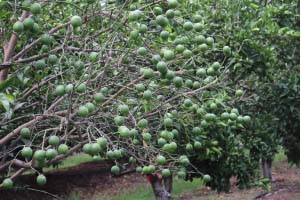Sweet Orange, botanically known as Citrus sinensis, belongs to the Rutaceae family. In India, it is commonly referred to as Mosambi. The sweet orange is native to southern Iran and is widely cultivated in the Mediterranean basin, the Middle East, Southeast Asia, and has adapted well to Indian conditions.
| SCIENTIFIC CLASSIFICATION | |
| Kingdom | Plantae |
| Class | Angiosperms |
| Order | Sapindales |
| Family | Rutaceae |
| Genus | Citrus |
| Species | sinensis |
| Botanical Name | Citrus sinensis |
REQUIREMENTS:
Soil: Sweet oranges can grow in a wide variety of soils, but loamy soil with good drainage and proper aeration is ideal for cultivation.
pH Level: The optimal pH range for sweet orange cultivation is between 5.5 and 7.5. However, the plant can tolerate pH levels as high as 8.5 and as low as 4.0.
Temperature: The optimum temperature for growth is around 30°C to 40°C, though the plant can tolerate temperatures up to 44°C.
Elevation: Sweet oranges can be successfully cultivated at elevations of up to 900 meters above mean sea level.
Climate: The plant is hardy by nature and thrives in dry, semi-arid, and subtropical conditions.
Irrigation Water: For successful cultivation, the electrical conductivity (EC) of the irrigation water should be less than 1.0 dSm⁻¹.
Nutritional composition of Citrus Fruits (per 100g of edible portion) –
| Component | C. sinensis (Sweet Orange) | C. paradisi (Grapefruit) | C. reticulata (Mandarin) | C. aurantifolia (Lime) | C. Limon (Lemon) |
| Moisture (g) | 88.4 | 88.5 | 87.8 | 84.6 | 85 |
| Protein (g) | 0.8 | 1 | 0.9 | 1.5 | 1 |
| Fat (g) | 0.3 | 0.1 | 0.3 | 1 | 0.9 |
| Fiber (g) | 0.5 | – | – | 1.3 | 1.7 |
| Carbohydrate (g) | 9.3 | 10 | 10.6 | 10.9 | 11.1 |
| Minerals (g) | 0.7 | 0.4 | 0.4 | 0.7 | 0.3 |
| Calcium (mg) | 40 | 30 | 50 | 90 | 70 |
| Phosphorus (mg) | 30 | 30 | 20 | 20 | 10 |
| Iron (mg) | 0.7 | 0.2 | 0.1 | 0.3 | 2.3 |
| Thiamine (mg) | – | 0.12 | 40 | 0.02 | 0.02 |
| Riboflavin (mg) | – | 0.02 | – | 0.03 | 0.01 |
| Niacin (mg) | – | 0.3 | – | 0.1 | 0.01 |
| Vitamin C (mg) | 50 | 31.2 | 68 | 63 | 39 |
| Carotene (µg) | – | – | 350 | 15 | -43 |
| Energy (Kcal) | 43 | 45 | – | 59 | 57 |
| Health Benefits – |
| Sweet oranges are an excellent source of Vitamin C, a powerful antioxidant that helps protect the body’s cells from damage caused by free radicals. |
| With a low glycemic index, sweet oranges promote a slower release of glucose into the bloodstream, helping to maintain stable blood sugar levels. |
| The high potassium content in sweet oranges can help lower blood pressure, promoting overall heart health. |
Sweet Orange – Nucellar
Sweet Orange – Nucellar variety is released from Maharashtra State. It has thin peel with less seed, golden colour juice with high Juice content

The Package of practices are prepared in following order –
– Care of young plants before plantation
– Plantation – Earthing Up Level
– Removal of Tape from Graft Union
– Grading
– Post Harvest Management Packaging
References:
Waleed Fouad Abobatta. Nutritional Benefits of Citrus Fruits. Am J Biomed Sci & Res. 2019 – 3(4).
https://ctclusi.org/wp-content/uploads/2020/12/health-benifits-of-oranges.pdf









